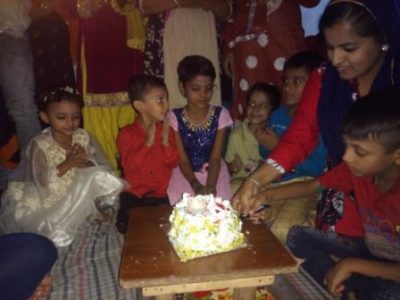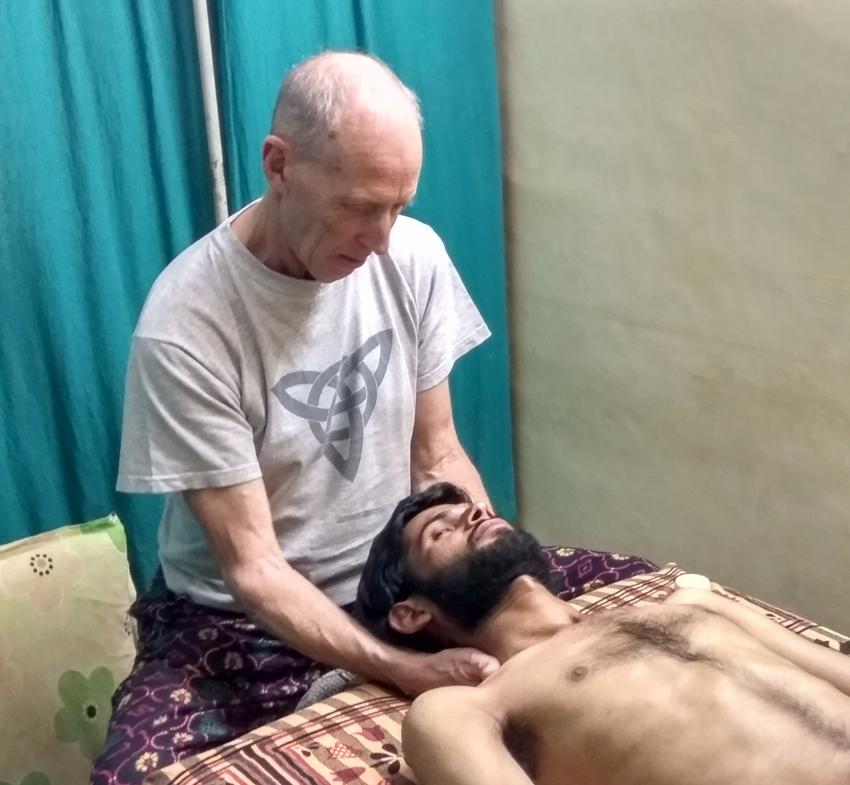
Ian Jarvis is a practitioner and tutor of ‘Spineworks’, a form of physical therapy focusing on the soft tissue of the body. Ian has just returned from his fifth trip to Bhopal, where he has been voluntarily offering his services at the Sambhavna clinic. Ian has been keeping a diary, recording some of his experiences of life in Bhopal and you can find his final post, for January, along with a round-up of his other posts here.
Ian has also been recording a video diary. These lovely videos can be found on Ian’s Facebook page BhopalToday, or on the BMA’s Facebook page. Please take a look for a real sense of the flavour of Bhopal.
Jan 2019 Final Round-up
January 19 2019: I am now sitting in my sister’s home back in the UK having been here for just over a week. During my first few days I eschewed all chilli from my food but now I am beginning to miss my 10 o’clock morning samosa from the café, cooked by Pushpah, Madhu or one of their assistants. There is a quiz night here next Friday, held by Amnesty International when samosa will be the chosen snack of the evening so I am looking forward to that, but none can match the freshly cooked ones of Sambhavna!
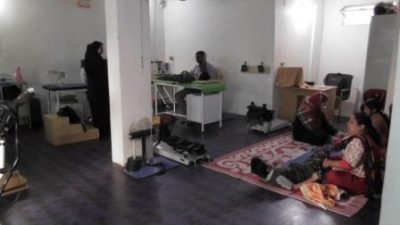
Volunteers: During this trip of three months (October 9 to January 8) I have met several other volunteers and also been alone for a couple of weeks. If you come here you are quite likely to meet others who are also offering their time and skills. I often have a rant about people who come here to help cleaning up the mess left by Union Carbide et al but fail to clean up their own mess in the kitchen. I would argue that there is a major disconnect when someone leaves dirty pans in the kitchen or used empty cups in their room, so if you plan to volunteer, please give some thought to how you will respect the needs of other volunteers while you are there. (Final rant over for this trip!)
Anniversary: It seems a long time ago but the 34th anniversary came and went on the 2nd and 3rd of December. The ICJB and the clinics always mark this occasion and this year was no exception. On the 2nd there was a candle vigil with a short walk from Kamla Park to Iqbal Maidan. Kamla park is located on the dam between the two main lakes, the Upper and the Lower, and is a lovely little park where boys are often found playing football or cricket. The walk went along the new bridge and up a hill where they reached the square that is Iqbal Maidan, in front of one of the oldest Mosques in Bhopal. In the square there were flowers and a range of photographs of remembered people. Photographer journalists took many pictures so I hope they were arrayed across the media to spread the word that people still are dying.
This part of anniversary remembrances is a strictly non-political event and is organised, I think, by Sambhavna. It is simply to remember the thousands of people who died in the incident and have died since with their health compromised.
Some stayed there to continue the vigil while others, myself and Thorsten (another volunteer) included went back to the Berasia Road to join a torchlight procession from Sindi Colony junction to the factory site.
The next day, a Monday, the clinics were closed. I rose at my usual 6 to 6:30 and had my usual small breakfast and tea. I like to make ‘English style’ tea in our accommodation and one or two locals (not all) here actually like it that way. We often take it in turns, someone will make Indian chai and later I will make English style tea. We had understood the parade would begin at 11:00 and the start was some distance away, but when it was about 10:30 and there was a knock on my door and two people were looking for banners for the parade, I realised I was in India. In the guest room that I usually occupy (age has its benefits!) is a large, high shelf which is used as a general store for a variety of ‘soft’ items. We found a ladder and many old banners whence appropriate ones were selected.
Thorsten and I took a rickshaw to the start along Hamidia Road to join a gathering throng of people including many from Sambhavna and Chingari. This march is a long route in hot sun to end by the factory gates where the traditional effigy burning ceremony was carried out.
Pachmarhi: It also seems like a long time since our adventurous trip to Pachmarhi. As those who have watched my videos* will know, I have become a de facto teacher of spoken English, and it was with a group of some 60 students of the school that we embarked at 00:30 (ie just after midnight) one Friday morning in early December. It would be several hours later as the sun increased its benevolence that we arrived, to the immense relief of some poor travellers who needed the open windows.
Pachmarhi is a small town in the hills of Madhya Pradesh which was used as a ‘hill station’ by troops and family of the British military and there is even a very ‘British’ looking Christian church near the centre.
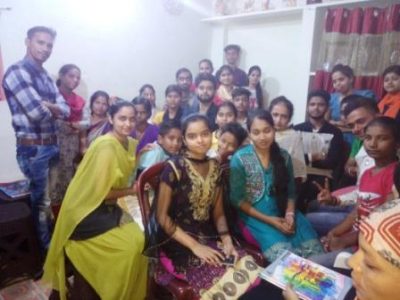
Much of the tourist activity centres around gardens, viewing places and scattered shrines. Rahul, the school principal, had organised several jeeps to ferry us around. I had an opportunity to speak individually with many of the people from the class that I usually taught as well as a few people from other classes. I was pleased that many of them wanted to speak with me both to learn more about me (and me about them of course) and to practice their speaking.
At one of the shrines I, or rather my bag, had a narrow escape when it was grabbed by a monkey and the contents investigated before, with help from the sadhu in the shrine, we were able to drive off the monkeys and retrieve it. Apart from a damaged bag and the screen of my phone all was OK.
We had a very late buffet-style lunch in one of the restaurants and the mandatory gazing at the sunset before reloading on our bus for the return trip. Some people were not looking forward to this, but it was fairly uneventful.
The bus stopped at the DIG roundabout and several of us alighted. It is only a short walk to the clinic from there and I arrived ‘home’ at 00:30 on the next day!
I must add that, before we stopped, 2 young 16 year-olds had ‘advised’ me to continue to the end and they would take me to Sambhavna by motor-bike. It was very sweet that two young guys were concerned for the safety of this old British guy, so, thank you, Shimon and Pathik for caring.
The Future? I speak to many people in Europe and India who are surprised that there are still people suffering from something that happened 34 years ago. I’m sure that many BMA supporters will also experience this. What is the future?
I really don’t know, of course, but I can guess and my assessment is that it will get worse, at least in the medium term.
This time I seem to have met more new registrations than on my previous trips. It may be my imagination, but I have had several patients coming and on their newly registered sheets (prior to getting a record book) they are mostly being prescribed remedies for their condition(s) as well as needing physical therapy. Many of the survivors who were teenagers or young adults in 1984 and are now in their 40s or 50s, might be hit by the double influence of ageing and long-term affects of the gas and water. I have seen estimates or guesses that there are over 100,000 survivors still with related sickness. Child survivors will be only in their late 30s so there is possibly another cohort which will include growing families as these get married, have children, and age.
This will add to the already large numbers of children suffering ill-health and disability down the generations transmitted unwittingly (even from breast milk) through their parents, grand-parents, and soon, great-grandparents. We are already seeing this in third-generation children.
I think there will be many more generations affected.
And, finally: I want to acknowledge the tremendous work done by all the clinics in Bhopal, now two Chingaris and Sambnavna, through the offices of all the staff. I have so many friends there now and want to thank everyone for helping me to feel so welcome and, even more, useful.
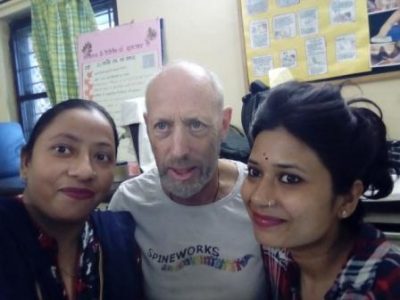
In particular, I must mention Shabnam in whose Observation Room I do my work causing not a little disruption to the normal schedule. We have many laughs together as well as serious discussions. One day I asked what a Moslem will do on a Hindu festival day. “Well”, she responded, “a festival IS a festival!” That just about sums up the complete religious tolerance and integration in Bhopal. Of course the other two nurses also deserve special mention, Aziza and Prabha.
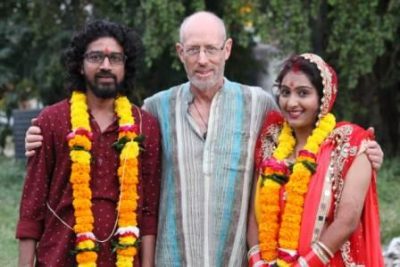
Naturally, then there is long-term volunteer, Devendra, ready to assist in many and any ways and whose wedding to Inderpal I will long remember, and Harshit another long-term but less frequent volunteer. The doctors, Jay, Roopa, Usha and Sattivan, who trust me enough to refer patients, and all the others with whom I don’t work but have become friends over the years; sisters Mahendra (pathology) and Ratna (garden), always the first to invite me to dinner, Nitesh (registration) ready with a big hug when I arrived, Kamil and Bhavesh (pharmacy), Rahul and Priyank (accounts), Prem (IT), Mukesh and Manmohan (garden) and especially the panchakarma therapists Beena, Geeta and Biju and yoga teacher/naturopath Shweta.
Last, and by no means least, recognition to Sathyu, creator of Sambhavna and who has announced his retirement in a couple of years. Over the years of my 5 visits we have become the best of friends even through occasional disagreements. What better friends can we have?
To those other volunteers who have shared a kitchen with me, I love you really!!!
* see facebook page “Bhopal Today” or Ian’s youtube channel, “SpineworksBodywork”.
Saturday 1st December
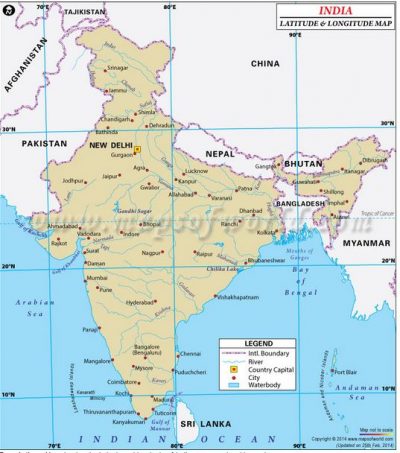
Where is Bhopal? Some of you reading this may not know exactly where Bhopal is. You can see it on the picture centrally located in the widest part of the country which makes it a good location for one of the biggest railway junctions in India. It’s a pity though that the airport is not an international one which means we have to fly via Mumbai or Delhi (usually) and then travel by domestic flight or train to Bhopal.
You might notice that it is just south of the tropic of Cancer which you cross over if you make a day trip to Sanchi, a historic Buddhist site. Geographically it is approximately 23°N and 77°E.
It is also known as “the city of lakes” for obvious reasons; there are lots of lakes, all of which are artificial. Most people visit the big one, created in the 11/12th century I think I recall. Most enjoyable for me is to start at Kamla Park which is on the dam dividing the ‘upper lake’ from the ‘lower lake’. It is a lovely, small park with a couple of interesting buildings and on the lower lake side, more gardens and a nursery. Then to cross the road and walk along the shore path to reach, eventually, the boat jetty. Here there are boats and pedallos for hire and you can make a trip to an island mausoleum. After that it is by now almost tradition with volunteers to walk up to Wind and Waves for refreshment, food and sunset. Definitely an auto-rickshaw back.
Despite not being a tourist destination, it does have some interesting features. It used to be a ‘rest and recreation’ centre for troops in the British occupation and there are many buildings redolent of that era. My favourite place is Bharat Bhavan, an art and theatre venue and I have attended many music and dance concerts there and enjoyed looking at the art on display. Just past the boat jetty is a large museum with both outdoor and indoor displays. There are many hotels also, from cheap and cheerful to atrociously expensive. The latter is the only place you can have a swim!
The Problem of Illiteracy: One thing that we just don’t think about in the ‘developed countries’ (so called!) is illiteracy. It is easy to send out a universal message on a flyer or leaflet. Here that is not a possibility. The radio and TV are also not possible for the campaigns here.
This is why I see many pictures around the clinic in addition to words on notices. I recall some years ago when ICJB* were organising a ‘lie-down’ on the railway, which had to be carefully planned and executed since we wanted no-one to be run over by a train though arrest or violence by the police was a strong possibility.
As luck would have it a photographer was visiting at the time and, although Nicholas was focusing on Chingari, he was borrowed by Sathyu to help create a pictorial set of guidelines which was taken around the neighbourhoods and proved to be highly successful. As did the railway demonstration, by the way.
So here are a couple of notices just outside the observation room where I work.
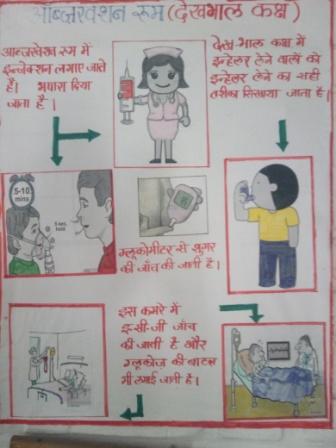
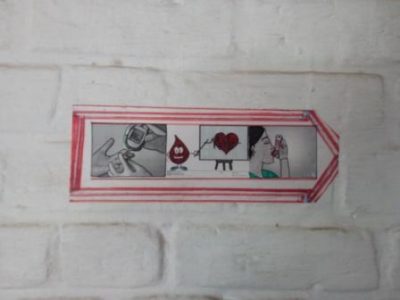
Chingari: During the month I planned to begin working at the Chingari clinic for two days a week. This clinic, also supported by the BMA, is a sister to Sambhavna. It was created in 2004 to give education, treatments and support to children with disabilities and their families. These are children born to couples who were affected by the gas or water and now they are well into the third generation with the rate increasing; currently 10 times worse than the average in the rest of India.
It was lovely to return there after several years and to be recognised by many of the staff and children. Sometimes this is what makes it all real and, in particular one young man, Umar, whom I had treated before when I volunteered here. I asked about his brother who I treated alongside him – they both ‘had’ muscular dystrophy, and I was told he had died. This was to be expected since this illness leads to a much reduced life-span. Rohit, a photographer journalist was visiting at the time for a few days and later in the week he and I went to Umar’s home to take some pictures. Azhar, “died on 22 December last year”, he was 31 years old and had been taken to the hospital for the last two days of his short life. Ayyud, his father showed us some pictures of him shortly before his death. He was the young man I remembered.
Umar is now fully aware of the fate that is just around the corner for him. His general health is better than his brother’s was so he may live a little longer, but he is now 24.
As it happened, I decided against sharing my time between both places. My workload at Sambhavna has been increasing with new patients almost daily and I can be working from 08:30 until 16:00 some days with barely 15 minutes for lunch. It is also hard to get people to understand that they don’t attend every day – even when many don’t in reality! I did make another of my interview videos though, with the three physiotherapists, Sanjay, Huma and Rishi, which you can see on the Bhopal Today page on Facebook. (This is a regular weekly feature.)
Weight problems: I see many overweight people on my table. I always advise about weight loss and sometimes refer them to Shweta, the yoga teacher and a Naturopathic Doctor, who has a responsibility for advising on diet. With the standard diet among many people here, not just the poor members of society, losing weight can be a challenge and, mentally, few are prepared to engage with it.
At least twice a day, the meal will be chapatti and rice with a daal and a small dish of vegetable. The rice and chapatti are the ‘filling’ foods and many people will eat 5 chapatti in one meal. Often breakfast is also rice based of some form of paratha (i.e. a thick version of chapatti!).
This makes a lot of carbohydrate in a day. Not surprising then that there is also a high incidence of diabetes.
Whenever I mention to someone that they need to lose weight if they want their back or knees (for example) to heal they smile and turn away.
Diwali: This year Diwali began on 7 November. Like the Christian Easter it is a “moveable feast” which means that the date each year is dependent upon the cycles of sun and moon. The festival lasts for 11 days. After Diwalli comes the marriage season in full swing. It is not the only time people get married of course but is a popular time.
Diwali is also known as the “Festival of Light” and many people will decorate their homes inside and out with candles, oil lamps and electric lights. In my UK birth city of Leicester, once the communal city lights go up for Diwali they stay up until after Christmas.
Diwali symbolises the spiritual “victory of light over darkness, good over evil and knowledge over ignorance”. It is probably the most popular festival in India, essentially Hindu but some other faiths also celebrate their respective festivals alongside it. The Jains observe their own Diwali, the Sikhs celebrate Bandi Chhor Divas, while Newar Buddhists, unlike other Buddhists, celebrate Diwali by worshiping Lakshmi. I asked Shabnam what she would do as she is a Moslem, if they did not celebrate it, “well”, she replied “a festival is a festival!” I think that is the attitude of most Indians.
There is one day of public holiday on which I went to eat with Beena who is one of the two Panchakarma therapists for women and who lives right opposite the gate to Sambhavna on the top floor with a great view far over Bhopal from her rooftop.
The next day I left Sambhavna with Ratna and dined with her family, many of whom attend the English coaching class I mentioned in my report last month.
Jain: AND, writing about Jain reminds me that we went to a Jain temple near the New Market area. We were invited one Sunday to visit the temple. Jain priests renounce everything and wander India naked with a brush with which they sweep the ground in front of them so they don’t inadvertently kill anything.
Jay’s family was also with us, (Dr) Roopa and the two children Meghnan and Manos and we were given a guided tour around. Aashi, daughter of Jay’s friend in the sect, became my personal guide for the next few hours. I met three priests and the picture is with one where I was ushered into that position! They also provide a good lunch for everyone.
I did wonder what the reaction in the UK would be to a naked man wandering from temple to temple, brushing the ground before him.
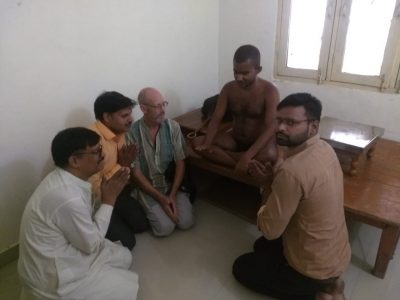
Friday, 02 November 2018
I have been at Sambhavna now for nearly 3 weeks on this, my fifth visit. It’s a good time of year for a British visitor as the weather is slowly cooling. For the first couple of weeks it was unusually hot, but now it is like very warm UK summer days and at night I don’t even need the fan.
My last visit was early in 2017, and since then there have been a couple of weddings for friends of mine – friends I have made through contacts at Sambhavna though neither works here. Amir was the first, late in 2017, he is a player of the sarod, and then Yasir earlier this year, who is an IT specialist. Both arranged marriages. Unfortunately I could attend neither wedding. However I was able to attend the ceremony of Devendra’s wedding the first week I arrived and did a video of the ceremony for them. Unusually for India, it was a very small affair with about 10 of us present and later in the evening about the same number at dinner. I have, of course met Deven’s wife and a couple of nights ago had dinner at Yasir’s home and, briefly, met his wife.
There have been several staff changes since my previous visit but still the majority remain. Many of the staff have been personally affected, either themselves or members of their families so they have a particular dedication to the clinic and the work.
There is a new (allopathic) doctor, Dr Usha, who is a cardiology specialist and also a new gynaecologist, Sonali. Shabnam and Aziza, the nurses and my trusty interpreters have been joined part-time by Prabha who also works as a staff nurse at the Hamidia Hospital. All but Raj of the guards (or Guardians) are new and there are sundry other people not all of whom I have met. The café (or canteen) is now run by Pushpah, who I got to know some years ago as the wife of one of my patients, and her very able daughter-in-law, Madhu.
I have renewed my friendly and interesting relationship with Diwaker who is responsible for the maintenance among other things. I always tell him about problems! He has said in the past that he’s generally grateful since he then knows about them and can fix them. So already he has had the hot water pipes from the solar collector cleaned of lime so now we have a flow of warm water. We hope that a pump will be added so that a hot shower is possible.
I plan to make a series of video interviews of some of the staff members (probably only the English speakers) and put them on my special Bhopal Facebook page – “Bhopal Today”. Pop over and ‘like’ or ‘follow’ the page and please share the videos as widely as you can simply to spread the word. Somewhere there is rich person who will be moved and inspired!
As an aside, there has been a fall in the general level of donations and this IS having an affect on the clinic in practical ways.
The first and current interview video though, was with two young volunteers who I met on my arrival here. Emma and Aileen qualified as physiotherapists earlier this year and wanted to come here before looking for jobs. In their university they had heard a talk by Tabish, who works at Chingari, the sister clinic, and had been inspired to want their first experience as unsupervised professionals to be here. Although they were working in Chingari they were staying at Sambhavna, since Chingari has no accommodation. They have now gone on their way so temporarily, I am alone.
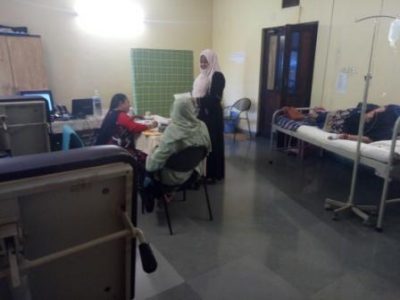
As is now becoming frequent if not regular, I have set up my table in the Observation Room where the nurses work. Shabnam, knew that I was coming this autumn but I had not written and told her when, so as I walked into the room she jumped up with surprise and gave me a big welcome hug, probably to the surprise of Prabha! Sometimes, if you don’t know a person, a hug is not quite the thing in India but age and familiarity are good signals it’s OK. By the time I was next in the room she and Prabha had moved the beds etc around so that I could put up my table.
When I first arrive I can be busy socially with several invites. Invitations to visit to homes are usually made by women and when you are a lone male that means that you will get few if any. If there are female volunteers also, then you may be invited along with them. With the ones who know me now though it seems fine to go as I am.
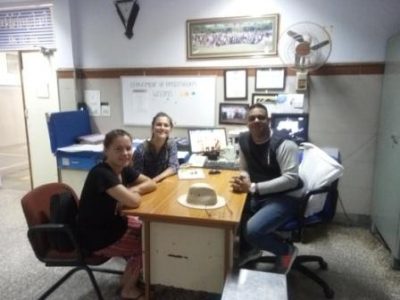
In conversation with Emma and Aileen I asked if they would like to see the inside of a hospital. I have met Aslam who runs the physio department at the Memorial Hospital and we keep in touch on an infrequent basis. I contacted him and he said we could visit anytime so they were able to see what physio is like, although the Memorial Hospital is the best of any that I have been in during my trips here and may not be typical. Aslam also showed us into one of the wards which was interesting – there was little concession to privacy and I noticed that several people had brought in food. I think that is not included in the hospital fees. This hospital, which is situated on the northern edge of the city and not entirely convenient to reach, was built with money given by Union Carbide.
Editors note: Although the BMHRC (Bhopal Memorial Hospital and Research Centre) technically may have been built with Union Carbide money it can hardly be seen as an act of benevolence. In October 1991 the Supreme Court ordered Carbide to construct a 500-bed hospital to meet the medical needs of the gas victims. The construction cost of the hospital and its running cost for eight years, which was estimated to be around £5million at that time, was to be borne by UCC and UCIL. The Bhopal Hospital trust raised its money by selling Union Carbide’s shares in Union Carbide India Limited which were in fact subject to an attachment order and, thus, effectively worthless to Carbide. See: 14-15 February 1989 – December 1993 for further detail.
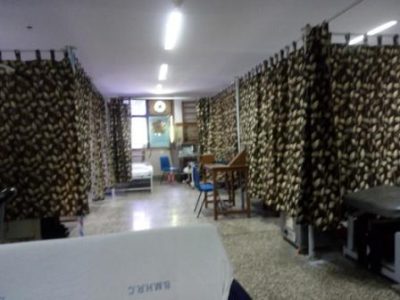
My first social lunch was one Sunday with Mahendra who heads the pathology department. Her youngest son, Aradhya, asked me if I would visit his English coaching class but that Sunday I was a little tired and said “not today, but I will”. This resulted in Ratna collecting me one afternoon as we closed and bundle me into front of an auto-rickshaw where she sat in the back with Mahendra (her sister) and Asha (one of the new cleaners). Ratna is the head gardener and Mahendra’s sister. I thought this was for dinner, but when we arrived at the house where she lives, next door to Mahendra, she took me out and after some minutes I found myself standing in front of a varied class of over 20 students in the English coaching class. One of the mantras of The Professional Speaking Association is always to be ready to give a presentation without warning. Here was my chance. For over three hours I had a conversation with the class and was immediately invited to return.
The next time, two days later, I was prepared and did an exercise that involved them doing most of the talking. There was much enthusiasm and excitement and of course some nervousness at speaking to the whole class but they all said they had enjoyed it. I am booked again! Now I just need to invent some more exercises for a fairly mixed range of ages and abilities. My impression, from some experience as well as observation and conjecture, is that much teaching is “old fashioned” and tends to stick with old formulas without much innovation. My session was all imagination and no experience!
In conclusion this time, please do go and check out “Bhopal Today” and watch the interview with Emma and Aileen. Share it around and mention that donations are reduced at the moment, the money goes much further here but they still need a regular supply.
